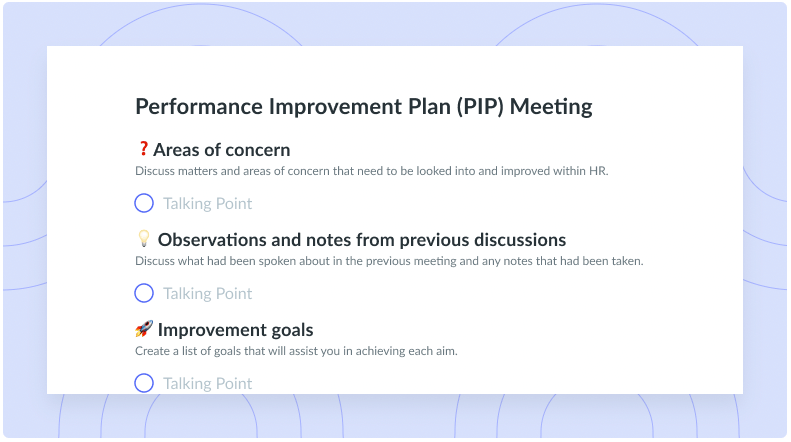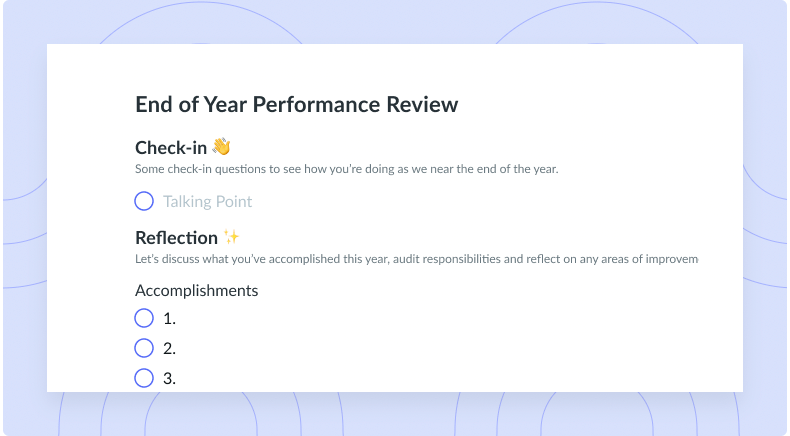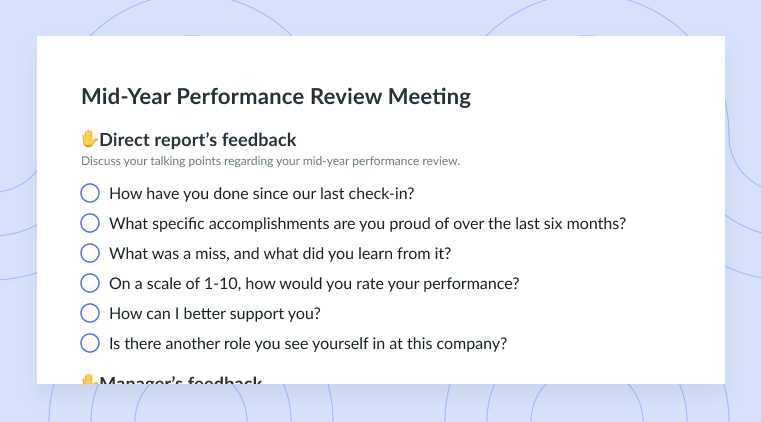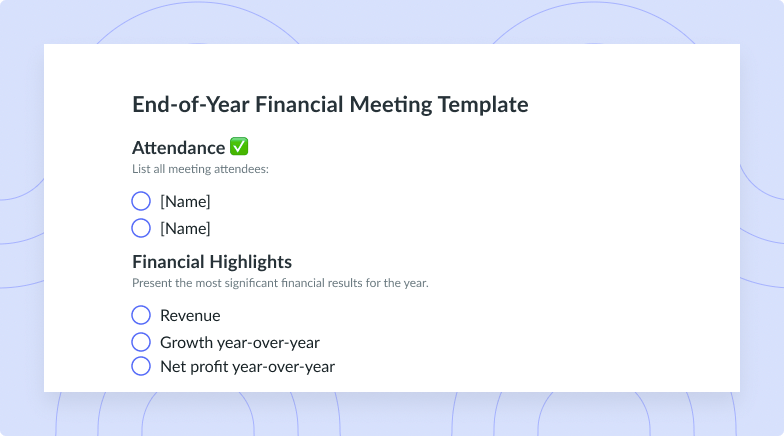Mastering the Art of Managing Performance in 2024
Managing performance systematically allows you to plan, track, review, and encourage employee growth more effectively!
Something as seemingly subjective as performance management can be measured in a lot of ways, which is why 81% of human resources leaders are looking to change how they approach it in their organization. Having a solid systematic framework can help both employees and team leaders plan for growth and track progress more effectively (and accurately). We’re going to dive into how to optimize your performance management process to make the most out of your employees’ growth!
- What is performance management?
- 4 stages of managing performance
- How to manage performance in 7 ways
- How to use Fellow to streamline performance evaluations and feedback
What is performance management?
Performance management is a way to monitor employees and ensure that they are working at levels appropriate to their roles. UC Berkeley uses this description:
“Performance management is an ongoing process of communication between a supervisor and an employee that occurs throughout the year, in support of accomplishing the strategic objectives of the organization.”
Things like work experience, behaviors, and achievements are all factored into performance management reviews. Typically, HR managers or team leads will conduct these reviews at least twice a year; some organizations may opt to do it quarterly or more frequently for underperforming employees. As a result of the reviews, employees may earn higher compensation, get promoted, or have a performance improvement plan implemented for them.

Elevate your team’s productivity and morale
Managing performance becomes a breeze, offering you insightful analytics, real-time feedback, and streamlined goal-setting features all in one platform. Try using a tool like Fellow!
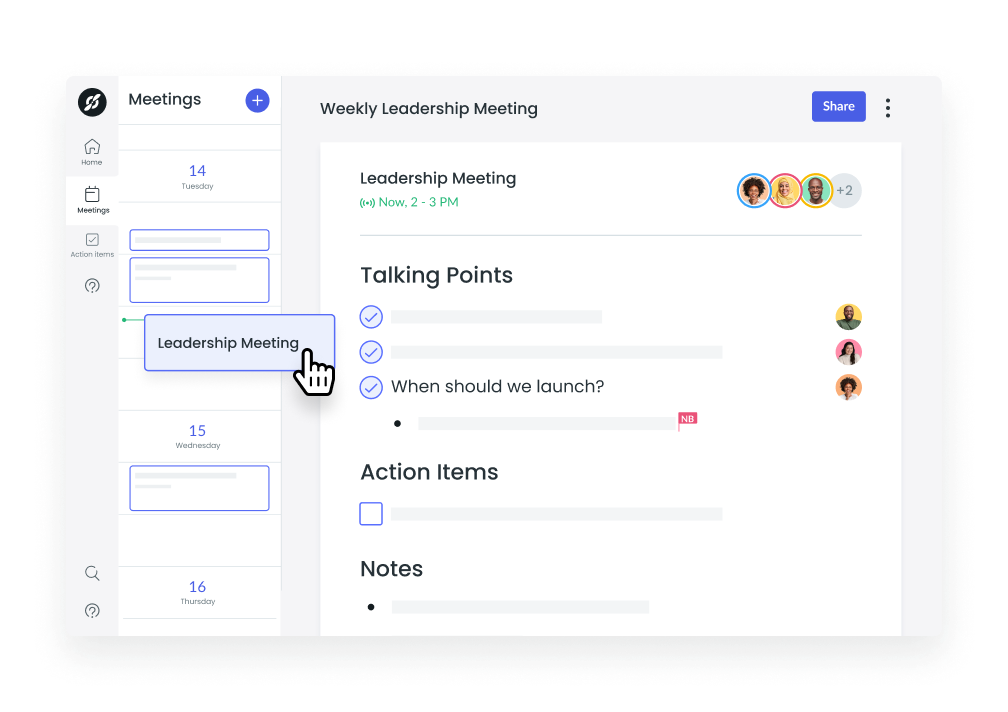
4 stages of managing performance
1Plan
Michael Armstrong created a handbook of performance management with a four-stage approach. The first stage of managing performance is to plan. With each employee, set aside time to determine goals and milestones. For each goal, make a reasonable and realistic estimate based on a set of guiding factors relevant to the goal. In the plan, also include a timeline for when the goals are expected to be achieved, any necessary resources that the employee can use, and a support plan in case they need assistance overcoming blockers.
2Act
Give the employee time to action the plan. As they work, make sure they have access to software, tools, and information that they’ll need to do their job well. Make sure you’re also available to answer any questions as they arise or at least offer employees a dedicated go-to person to address those concerns (such as an HR manager or a project manager who would have better insights).
3Track
Measuring goals is important. A tracking system should be agreed upon and implemented before the employee starts to execute their plan. Depending on the type of work they’re doing, it might make more sense to track as they go or to do a tally or calculation at the end. The employee should be fully aware of what is being tracked and what the results will mean for their performance evaluation in the next stage.
4Review
When the next agreed-upon performance review period arises, it’s time to do a review. In a one-on-one with each employee, share the results that you’ve tracked so far. Give them an opportunity to share any challenges, solutions, and lessons that they’ve learned along the way. Keep in mind that the employee’s personal experiences or life outside of work may have had some impact on their performance. At the end of every review period, ensure you’ve set a new plan with the employee to ensure they achieve an adjusted or different goal by the next performance evaluation.
How to manage performance in 7 ways
- Set clear goals
- Encourage self-evaluation
- Recognize and reward accomplishments
- Have regular check-ins
- Use a performance management software
- Provide opportunities for continuous learning
- Create a performance improvement plan
Set clear goals
SMART goals are specific, measurable, attainable, realistic, and time-bound. Creating your goals to be as quantitative and trackable as possible ensures that there is no subjectivity. As a result, you’re a lot more likely to drive alignment between your needs and your employees, which in turn will provide a higher chance of seeing those goals attained.
A tool like Fellow can host your long-term goals so you and your employee can both check in on them periodically. Then, during the performance review, you can reflect on them to see if the original goals have been attained.
Encourage self-evaluation
When managing performance, you want to encourage employees to also self-reflect on their progress. Since formal performance evaluations only take place a few times a year, employees need to be able to monitor their own activity to know if they are on track or not. You can encourage self-evaluation by providing constructive feedback in one-on-one meetings with Fellow or by offering them self-evaluation performance review examples or templates that they can use to track their own results between performance check-ins.
Recognize and reward accomplishments
The key to motivating employees to accomplish a big goal is to celebrate the small wins along the way! Setting up a #shout-outs channel in Slack or Microsoft Teams can greatly improve morale since employees will encourage each other as wins happen. Or, if you prefer to celebrate someone’s success face to face, you can add shout-outs to the first part of your one-on-one meeting agenda so that you don’t forget to bring them up or add shout-outs to the beginning of your team meetings! Celebrating as a group can be a fun way to improve performance and motivation across your wider team.
Have regular check-ins
Don’t wait until the yearly check-in to provide feedback. A best practice is to set up weekly or bi-weekly one-on-one meetings with each member of your team. In these calls, you can ask about progress and see if there are any blockers preventing employees from reaching their goals. You can also learn about any personal concerns that might be affecting an employee’s performance. When you identify areas of improvement on the fly, you can track them in Fellow so they will automatically be added to the employee’s overarching to-do list. This helps keep them accountable for their work across the whole year!
Use a performance management software
Performance management software allows managers to check in on progress without needing to manually review notes or keep tabs from memory. Fellow, for example, allows you to post goals in a shared location. Then in each meeting, with the help of AI, Fellow can prompt you to ask about meeting progress and it will store the update in an automatically generated meeting summary. From there, tools like Jira can be used to track the status of individual to-do items and BambooHR can be a formal place to record the results of performance-related conversations.
Provide opportunities for continuous learning
Managing performance is not only about judging how well an employee has done so far; it’s also about providing new opportunities for continuous learning. As an employee learns and grows, they’ll continue to excel in their career at your company. This can make them better at decision making, make them more creative or innovative, and lead them to stay with the company longer—which means a higher employee retention score for the organization. As employee loyalty and value grows during their time at your company, you’ll actually save on HR costs too, which is an added bonus!
Create a performance improvement plan
A performance improvement plan (PIP) Is designed to encourage underperformers. If you notice someone on your team hasn’t achieved their targets in the last two or more performance evaluations, it might be time to consider implementing a PIP. This approach is a written document that outlines where the employee is currently failing, as well as a short-term solution that is aimed to get them back on track. If your normal performance evaluation period is every quarter, you can choose to have check-ins every month instead, for example. The PIP should include very actionable and attainable goals for the employee, as well as a list of resources they can rely on for help. You may also include suggested next steps if the PIP is not achieved within the set period.
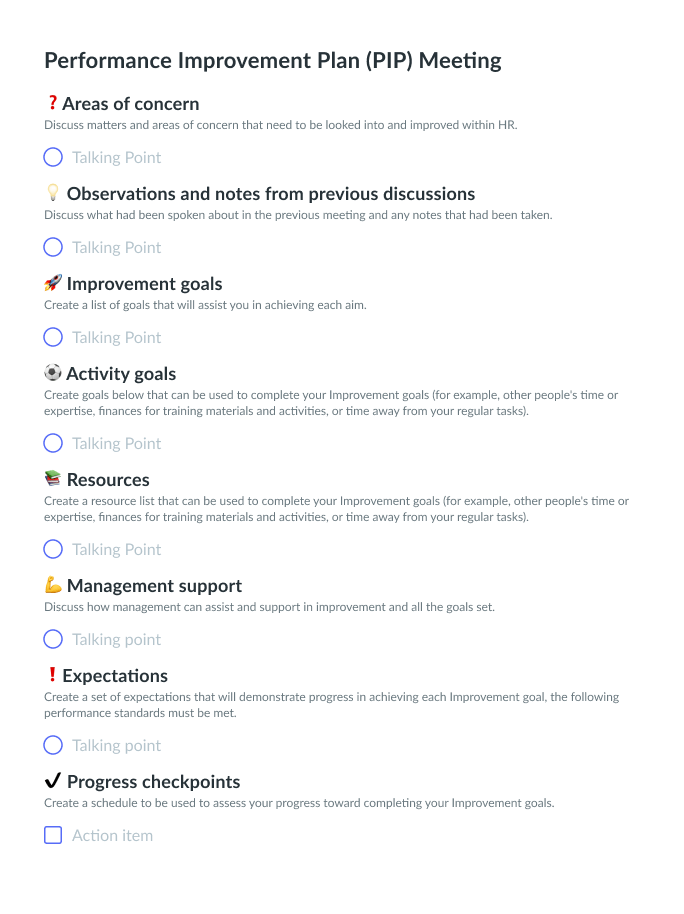
How to use Fellow to streamline performance evaluations and feedback
Fellow is a meeting management software that allows managers to track their entire team’s progress from one spot. For example, Fellow has a 360-degree feedback tool where you can customize the questions for each evaluation group, send out the requests for feedback, and have it all gathered in one place for easy review. Then, you can compare the results of the 360 feedback to the employee’s personal goals and performance plan—which is also documented within Fellow.
Between performance evaluation periods, you can host one-on-one meetings with team members to address any blockers they might be facing. You can also use this time to adjust goals based on each person’s current situation. All of this activity will be documented in the tool so you can reference it in later conversations if need be.
As you get started with hosting performance review meetings, you might also want to check out these templates that can guide your conversation!

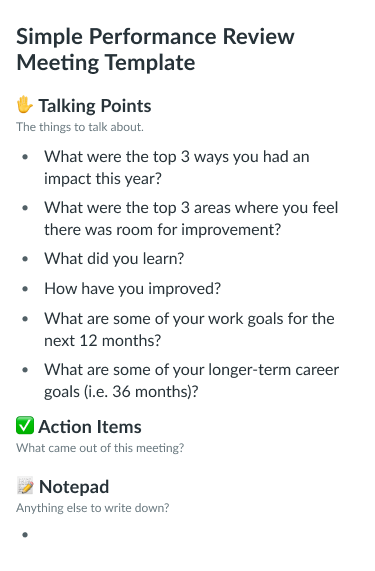
Parting advice
Managing performance, whether for an individual or for a team, is no easy feat. As a manager, there is a lot of pressure on you to ensure that you’re tracking information accurately and providing realistic goals for your team. Instead of holding onto this responsibility manually, you can offload some of the work to a performance management software like Fellow. This way, you’ll automate repeatable tasks like the distribution of feedback surveys or get extra insights on performance by receiving notifications of overdue action items, for example. The more data you have at your fingertips, the more informed you’ll be when it comes to leading performance review conversations!
![360 Degree Feedback Tools: Top 8 [2024]](https://fellow.app/wp-content/uploads/2023/12/2.jpg)


![Effective Performance Improvement Plan [+ Free Template]](https://fellow.app/wp-content/uploads/2023/04/Performance-Improvement-Plan3.jpg)
![Level Up Your Software Engineer Performance Review [+Examples]](https://fellow.app/wp-content/uploads/2022/09/Software-Engineer-Performance-Reviews.jpg)


![10 Effective Strategies to Improve Employee Performance [+ Free Template]](https://fellow.app/wp-content/uploads/2020/07/Improving-employees-performance.png)

